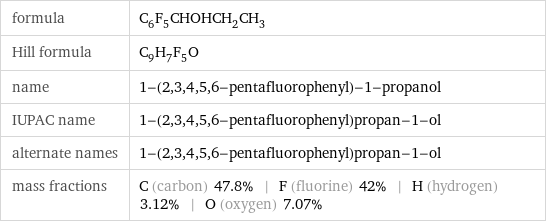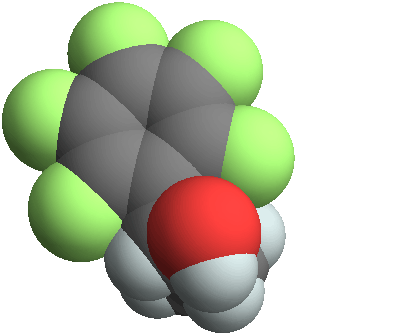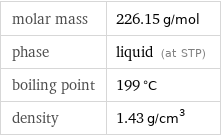Input interpretation

1-(2, 3, 4, 5, 6-pentafluorophenyl)-1-propanol
Chemical names and formulas

formula | C_6F_5CHOHCH_2CH_3 Hill formula | C_9H_7F_5O name | 1-(2, 3, 4, 5, 6-pentafluorophenyl)-1-propanol IUPAC name | 1-(2, 3, 4, 5, 6-pentafluorophenyl)propan-1-ol alternate names | 1-(2, 3, 4, 5, 6-pentafluorophenyl)propan-1-ol mass fractions | C (carbon) 47.8% | F (fluorine) 42% | H (hydrogen) 3.12% | O (oxygen) 7.07%
Lewis structure

Draw the Lewis structure of 1-(2, 3, 4, 5, 6-pentafluorophenyl)-1-propanol. Start by drawing the overall structure of the molecule, ignoring potential double and triple bonds: Count the total valence electrons of the carbon (n_C, val = 4), fluorine (n_F, val = 7), hydrogen (n_H, val = 1), and oxygen (n_O, val = 6) atoms: 9 n_C, val + 5 n_F, val + 7 n_H, val + n_O, val = 84 Calculate the number of electrons needed to completely fill the valence shells for carbon (n_C, full = 8), fluorine (n_F, full = 8), hydrogen (n_H, full = 2), and oxygen (n_O, full = 8): 9 n_C, full + 5 n_F, full + 7 n_H, full + n_O, full = 134 Subtracting these two numbers shows that 134 - 84 = 50 bonding electrons are needed. Each bond has two electrons, so in addition to the 22 bonds already present in the diagram add 3 bonds. To minimize formal charge carbon wants 4 bonds. Identify the atoms that want additional bonds and the number of electrons remaining on each atom: Fill in the 3 bonds by pairing electrons between adjacent highlighted atoms. Note that the six atom ring is aromatic, so that the single and double bonds may be rearranged: Answer: | |
3D structure

3D structure
Basic properties

molar mass | 226.15 g/mol phase | liquid (at STP) boiling point | 199 °C density | 1.43 g/cm^3
Units

Liquid properties (at STP)

density | 1.43 g/cm^3 refractive index | 1.443
Units
